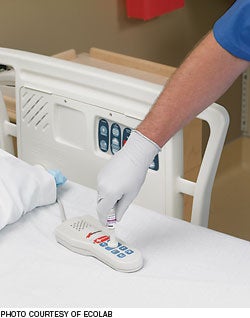Enhanced cleaning may reduce infections
 Enhanced cleaning methods in intensive care units (ICUs) may reduce the transmission of methicillin-resistant Staphylococcus aureus (MRSA) and vancomycin-resistant enterococci (VRE), according to a clinical study recently published in the Archives of Internal Medicine.
Enhanced cleaning methods in intensive care units (ICUs) may reduce the transmission of methicillin-resistant Staphylococcus aureus (MRSA) and vancomycin-resistant enterococci (VRE), according to a clinical study recently published in the Archives of Internal Medicine.
Baseline research conducted from Sept. 1, 2003, through April 30, 2005, showed that admission to an ICU room previously occupied by a patient with MRSA or VRE had a 40 percent increased risk of acquisition. The new study is based on a cleaning intervention that was conducted from Sept. 1, 2006, through April 30, 2008, in 10 ICUs in Brigham and Women's Hospital, Boston.
MRSA and VRE acquisition decreased during the intervention. MRSA acquisition fell from 3 percent in the baseline study to 1.5 percent during the intervention, and VRE acquisition dropped from 3 percent in the baseline to 2.2 percent during the intervention.
The risk of MRSA acquisition increased during the baseline study to 3.9 percent from 2.9 percent when prior patients were MRSA negative. During the intervention period, the risk of acquisition remained at 1.5 percent regardless of whether the prior occupants carried MRSA.
Patients in rooms previously occupied by VRE carriers had an increased risk of acquisition during the baseline of 4.5 percent compared with 2.8 percent when the prior patient was VRE-negative. Risk of VRE acquisition increased during the intervention to 3.5 percent when prior occupants were carriers, compared with 2 percent when prior occupants were VRE-negative.
Methods used in the intervention included increasing the volume of disinfectant used, educating staff on best practices and monitoring thoroughness of cleaning.


